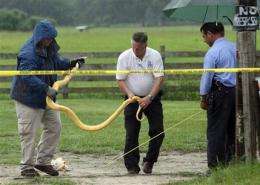From pythons to fungus, species invading US

(AP) -- A pet Burmese python broke out of a glass cage last week and killed a 2-year-old girl in her Florida bedroom. The tragedy became the latest and most graphic example of a problem that has plagued the state for more than a decade: a nonnative species that is wreaking havoc in the Everglades, threatening people, the environment and native wildlife.
"It's just a matter of time before one of these snakes gets to a visitor in the Florida Everglades," said Sen. Bill Nelson, D-Fla.
Nelson has introduced a bill to ban imports of the snakes, after years of trying to persuade federal wildlife officials to restrict their entry into the country.
Nelson was one of several senators who warned about the threat of invasive species at a hearing Wednesday.
From a mysterious fungus attacking bats in the Northeast to zebra mussels in the Great Lakes and snakehead fish in the Chesapeake Bay watershed, native wildlife is facing new threats nationwide.
Lawmakers are considering a variety of measures to address the problem, including a bill that would more closely regulate ballast water discharge to ensure that invasive species do not enter the country through oceangoing vessels. Ballast water, which keeps ships stable in rough seas, is blamed for carrying zebra mussels and many other invasive species into U.S. waters where they have overwhelmed native species and caused other environmental harm.
The Environmental Protection Agency has started regulating the ballast water of oceangoing ships for the first time under the Clean Water Act, although many state standards are more stringent. Environmentalists say more extensive treatment of ballast tanks is necessary to keep invasive species out.
Sen. Carl Levin, D-Mich., said he supports a strong national standard for ballast water treatment that would remain in place for several years, giving ship owners time to develop new technology. Levin also supports a ban on imports of Asian carp, but said the aquatic species plaguing Michigan are no match - in size anyway - for the Burmese python, which can grow to 18 feet and has been known to eat alligators and even deer.
Photos that showed the python were displayed at a hearing conducted by two Senate Environment and Public Works subcommittees.
Burmese pythons are native to southeast Asia, but they survive easily in Florida's warm, moist climate.
Some owners have freed the fast-growing pythons into the wild and a population of them has taken hold in the Everglades. Scientists also speculate that a bevy of Burmese pythons escaped in 1992 from pet shops battered by Hurricane Andrew and have been reproducing ever since.
Lawmakers also discussed the fungus killing Northeastern bats. Since it was discovered in a cave in upstate New York in 2007, the so-called white-nose syndrome has spread to 65 caves in nine states, and killed at least 500,000 bats. The disease now ranges from West Virginia to Vermont and could expand across the country, officials said.
Sen. Frank Lautenberg, D-N.J. called the fungus a serious threat to the health, environment and economy of the East Coast.
"Bats are on the front line of defense in protecting the public's health and our crops, Lautenberg said, noting that bats prey on insects such as mosquitoes, moths and beetles.
"With fewer bats, there are more mosquitoes to breed disease and more insects to destroy the crops grown on New Jersey's farms, threatening the livelihood of our farmers and damaging our economy," Lautenberg said.
Gary Frazer, assistant director for fisheries and habitat conservation for the U.S. Fish and Wildlife Service, said the agency has spent nearly $6 million since 2007 studying the bat problem and trying to find solutions. The agency and the Forest Service also have closed caves to people on forest lands in 33 states and urged the public not to enter caves or abandoned mines in states with white-nose syndrome. While there is no evidence the people can be harmed by the fungus, they may be contributing to its spread.
Sen. Ben Cardin, D-Md., said better public education is needed to make Americans more aware of the dangers of exotic pets and invasive species.
---
On the Net:
Senate Environment and Public Works Committee: http://epw.senate.gov/
©2009 The Associated Press. All rights reserved. This material may not be published, broadcast, rewritten or redistributed.















